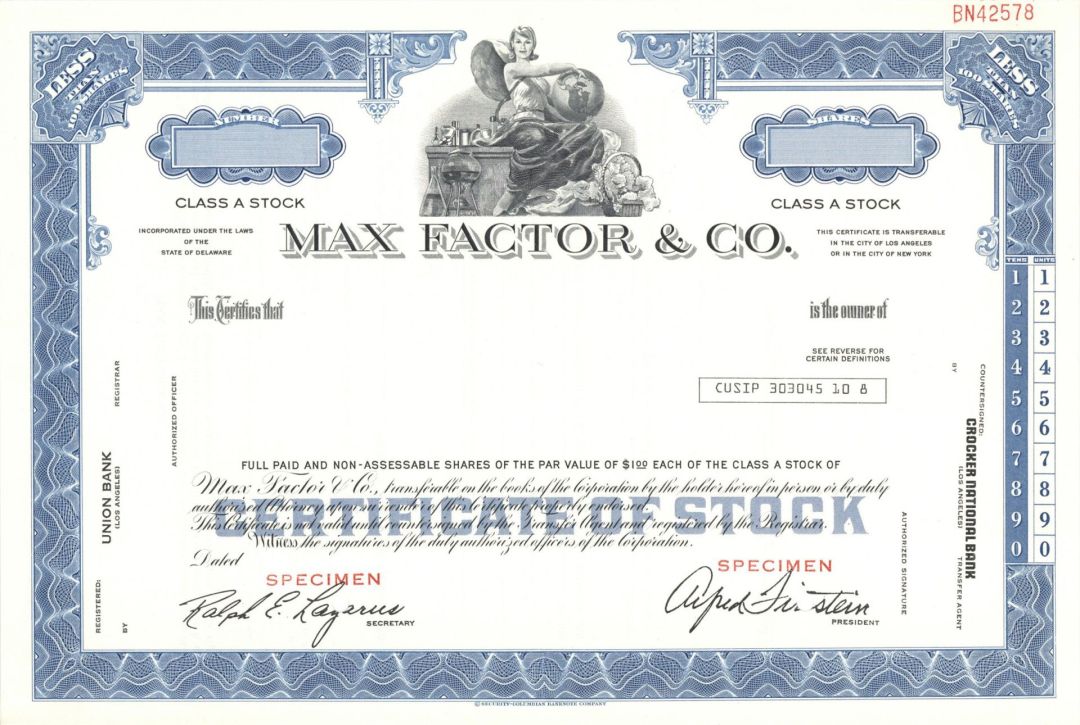Max Factor and Co. - Specimen Stock Certificate
Inv# SE3884 Specimen StockDelaware
New York
Specimen Stock printed by Security-Columbian United States Banknote Company.
Max Factor is a line of cosmetics from Coty, founded in 1909 as Max Factor & Company by Maksymilian Faktorowicz. Max Factor specialized in movie make-up. Until its 1973 sale for US$500 million (approximately $3.5 billion in 2017 dollars), Max Factor & Company was owned by several generations of the family, becoming an international company during that time. Procter & Gamble purchased it in 1991.
Max Factor was born Maksymilian Faktorowicz in Congress Poland, and later moved to Moscow where he was employed as a wig maker. After immigrating to the United States in 1904, Factor moved his family and business to Los Angeles, California, seeing an opportunity to provide made-to-order wigs and theatrical make-up to the growing film industry. Besides selling his own make-up products he soon became the West Coast distributor of both Leichner and Minor, two leading theatrical make-up manufacturers. When the film industry was beginning to evolve, stick greasepaint (although the accepted make-up for stage use) could not be applied thinly enough, nor did the colors work satisfactorily on the screen. Factor began experimenting with various compounds to develop a suitable make-up for the new film medium. By 1914 he had perfected his first cosmetic product. With this major achievement to his credit, Max Factor became the authority on cosmetics in film-making. Soon movie stars were eager to sample his "flexible greasepaint". For the first few years of the business, Factor personally applied his products to actors and actresses. He developed a reputation for being able to customize makeup to present film stars in the best possible light on screen. Among his most notable clients were Mabel Normand, Ben Turpin, Gloria Swanson, Mary Pickford, Pola Negri, Jean Harlow, Claudette Colbert, Bette Davis, Norma Shearer, Joan Crawford, Lucille Ball and Judy Garland. As a result, virtually all of the major movie actresses were regular customers of the Max Factor beauty salon, located near Hollywood Boulevard. In 1918, Max Factor completed development of his "Color Harmony" face powder which, due to its wide range of shades, allowed him to customize and provide more consistent make-up for each actor. He created many unique looks for notable actresses, such as Clara Bow's heart-shaped/pierrot lips. Years later, he exaggerated Joan Crawford's naturally full lips to distinguish her from the many would-be stars copying the Clara Bow look. He also created specific shades: Platinum (Jean Harlow), Special Medium (Joan Crawford), Dark (Claudette Colbert) and Light Egyptian (Lena Horne). For Rudolph Valentino, he created makeup to complement the actor's complexion and mask the darkness of his skin on screen. In 1920, Max Factor accepted his son Frank's suggestion and officially began referring to his products as "make-up," based on the verb phrase "to make up" (one's face). Until then the term "cosmetics" had been used; "make-up" was considered vulgar, to be used only by people in the theater or of dubious reputation and not in polite society. In 1922, while on holiday in Europe with his wife, Factor visited the Leichner headquarters in Germany. He was by then the biggest retailer of their theatrical stick greasepaint, yet Factor was snubbed and kept waiting at reception. Upset at this treatment, he left and immediately cabled his sons to begin selling his own brand of greasepaint. Until then, Factor had made his own greasepaint for his clients, but had made no attempt to market it while he was representing other brands. Now he concentrated on his own products, which he offered in a collapsible tube instead of in stick form. His tube greasepaint was not only more hygienic, but could be applied thinly and evenly. Soon Max Factor's version was the leading brand. By the 1920s, his sons Davis and Frank were heavily involved in the business, with Davis the general manager and Frank assisting his father in the development of new products. In 1925, the company received its biggest order to date when it had to complete a rush order to supply 600 gallons of light olive makeup for the movie Ben-Hur to ensure the skin color of the extras used in filming undertaken in America would match that of the darker-skinned Italian extras in the scenes filmed in Italy. For the 1926 film Mare Nostrum, Max and Frank Factor developed the first waterproof theatrical make-up. By the 1920s, Max Factor was becoming known outside the film community, which led to the company developing an in-house PR department in the early 1930s. Read more at https://en.wikipedia.org/wiki/Max_Factor
Stock and Bond Specimens are made and usually retained by a printer as a record of the contract with a client, generally with manuscript contract notes such as the quantity printed. Specimens are sometimes produced for use by the printing company's sales team as examples of the firms products. These are usually marked "Specimen" and have no serial numbers.










Ebay ID: labarre_galleries